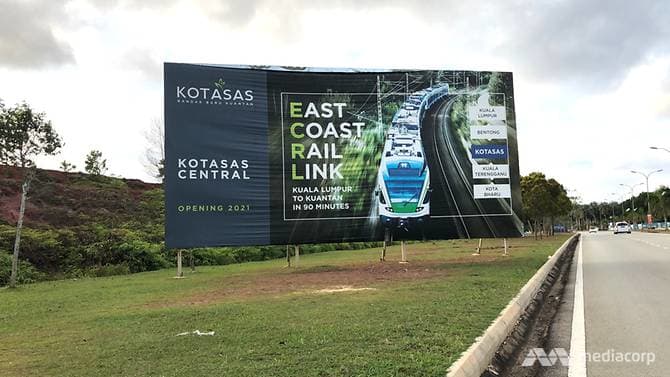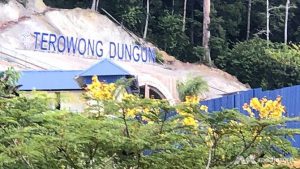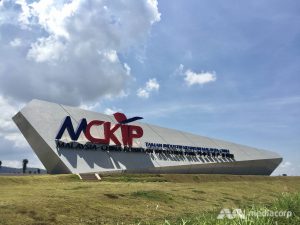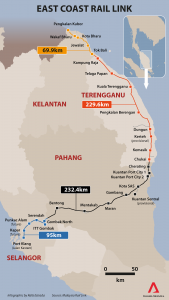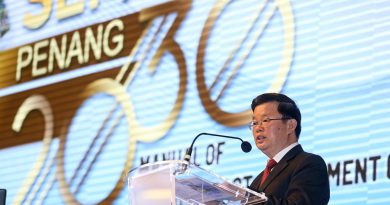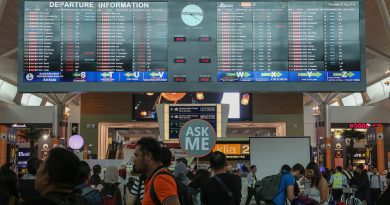Businesses, residents hope Malaysia’s East Coast Rail Link will go ahead despite cancellation fears
KUALA LUMPUR: Mr Hamid Salleh, 68, has to wait for hours, especially during festive seasons, for his grandchildren to return to Terengganu from Kuala Lumpur.
“Now, half of your day will be gone … crawling along the LPT (East Coast Expressway) during festive seasons (to reach home),” said the father of eight. At times, he resorts to driving all the way to Kuala Lumpur, just to be with his grandchildren.
When news first broke that the East Coast Rail Link (ECRL) would provide a fast connection between Kuala Lumpur and the three east coast states – Kelantan, Terengganu and Pahang – Mr Hamid hoped that his four sons and four daughters could be with him immediately, whenever he needs them.
Travelling from Kuala Lumpur to Kota Bharu, Kelantan, now takes eight hours by car through the LPT. With the ECRL’s speed of up to 160kmh, the journey will be shortened to just four hours.
He envies those living on the west coast, who have benefitted from the Electric Train Service (ETS) linking Kuala Lumpur to Padang Besar, Perlis. With a distance of 544km, the whole journey takes just five hours and 30 minutes.
“Even Thailand can have a railway linking Bangkok to Sungai Kolok (at the Malaysia-Thailand border) in 23 hours. Why not the east coast then?” he asked rhetorically, adding that a rail project will improve everyone’s life directly or indirectly.
With talk that the ECRL might be cancelled or delayed, residents such as Mr Hamid hope the government will continue with the project, even if it is downsized, in order to enhance connectivity for the region.
Businesses, in particular, say the ECRL will be a game changer in terms of attracting investment and talent.
The ECRL would see 44 tunnels created from Pahang to Kelantan.
The Dungun Tunnel, which is situated within Bukit Bauk Forest Reserve, Terengganu, is one of the sites where some construction has been completed.
Some work has also been carried out at Bentong Tunnel located not far from Sungai Marong Recreation Park, Pahang.
When Channel NewsAsia went to the two tunnels, all construction activities appeared to have been halted, while Putrajaya and Beijing negotiate how to take the project forward at a lower cost.
Several locations identified as ECRL stations, such as KotaSAS, Cherating, Chukai and Kuala Terengganu have no physical structures erected yet.
ATTRACTING INVESTMENT AND TALENT
The business community is confident that the ECRL would bring economic opportunities.
Mr S Nagarajah, the Chairman of Pahang Indian Chamber of Commerce and Industry said the ECRL will attract people from other states as well as foreign investors to do business
Citing the Malaysia-China Kuantan Industrial Park (MCKIP) development previously, Mr Yusri said the value of land surrounding the area had increased as many people bought the land from villagers.
“Now, the villagers are smart. They don’t usually sell their land to make fast money. In fact many of them set up a joint venture with developers … This is a win-win situation,” he said.
Mr Yusri, who is also a contractor, hopes that a new township will grow at every ECRL station.
Kota SAS, a new township for Pahang’s administrative centre, is already growing with residential houses and public amenities.
He believes that the ECRL will eventually take off, even if it is on a smaller scale.
“Sooner or later, by hook or by crook, we must have such a project as the cost would not be the same in 10 to 20 years from now.”
He suggested that the government could replicate the highway concession concept, where longer concession periods could lead to lower commuter fares.
The ECRL, more than 600km in length, was expected to be completed in 2024 at a final cost of RM81 billion (US$19.9 billion).
It comprises two phases, with Phase 1 stretching about 600km from Kota Bharu to the Integrated Transport Terminal in Gombak, Selangor.
The second phase involves a northern extension (Kota Bharu-Wakaf Baru-Pengkalan Kubor) in Kelantan and a southern extension (Gombak North-Serendah-Port Klang) in Selangor.
The rail link will run through three opposition states: Pahang, Terengganu and Kelantan.
China Communications Construction Co Ltd is the main contractor for the mega-rail project.
The ECRL was approved by the previous BN government in October 2016.
However, after winning the 14th General Election in May 2018, the current Pakatan Harapan government is taking a second look at the project, in a bid to cut the country’s massive RM 1 trillion debt.
There was talk that the ECRL has been cancelled.
Last month, however, Prime Minister Mahathir Mohamad said a final decision on the project has yet to be made.
“We should allow the discussions which will now be held between government-to-government, and away from the public glare,” said Finance Minister Lim Guan Eng.
OPTIONS TO MANAGE COST
Those interviewed noted that there are more financially prudent options to construct the rail link.
Mr Hamid, who is also Chairman of Terengganu Livestock Association, said that rather than paying RM500 million as interest cost to cancel the ECRL, it would be better to have a smaller scale project similar to the ETS.
The ETS, which operates on the metre gauge, has a lower train speed as compared to the ECRL, which runs on the standard gauge. The metre gauge is also generally cheaper to build.
“Paying compensation and getting nothing is just a waste. Why not do one with smaller scale, something like ETS with cargo capacity,” he said.
Mr Koh Teck Seng, 62, a Kuantan resident opined that the ECRL could be built along the LPT.
“(The LPT) passes through most of the main towns on the east coast. Bulk of the cost for land acquisitions might be reduced,” said the former teacher.
Most of the ECRL stations were planned to be close to the LPT exits.
The 358km LPT links Kuala Lumpur to Kuala Terengganu. There has been talk of extending the expressway so that it can connect to Kota Bharu.
While eagerly expecting the ECRL project to materialise, Mr Koh expressed hope that the government would also consider the environmental implications.
“If not, it would be more useful for the money to be used for mitigating flood. Everyone knows that the east coast is a flood-prone area especially during monsoon season,” said Mr Koh.
Source : ChannelNewsAsia

